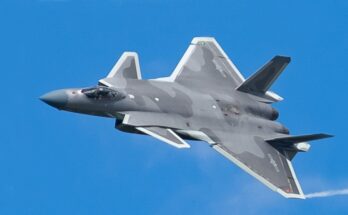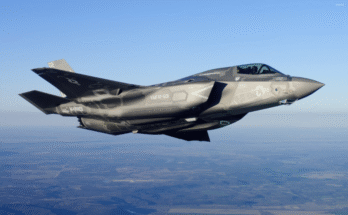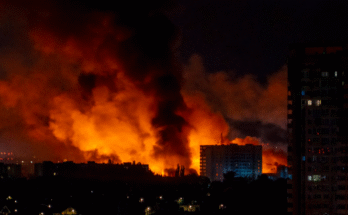The Northrop Grumman B-21 Raider is the United States’ next-generation stealth bomber, designed to replace the aging B-1 Lancer and B-2 Spirit fleets. As the first new bomber developed in over three decades, the B-21 represents a major leap in long-range strike capability, combining stealth, endurance, and digital innovation. Its development is part of the U.S. Air Force’s Long-Range Strike Bomber (LRS-B) program.

1. Program Overview
- Prime Contractor: Northrop Grumman
- Key Partners: Pratt & Whitney (engines), BAE Systems, GKN Aerospace, Janicki Industries, and others
- Development Location: Northrop Grumman’s B-21 program is headquartered in Palmdale, California, at Air Force Plant 42
- First Public Unveiling: December 2, 2022
- First Flight: Conducted in 2023; initial operational capability expected before 2030
- Planned Fleet: At least 100 units (potentially more depending on Air Force needs)
2. Digital-First Development
The B-21 is the first U.S. bomber developed entirely using digital engineering tools, making it one of the most efficient and agile defense acquisition programs in history.
- Digital Twins: Virtual replicas of the aircraft were created to test aerodynamics, stress tolerances, and component performance before physical prototypes were built.
- Model-Based Systems Engineering (MBSE): Allowed rapid iterations, risk reduction, and simulation of different combat scenarios.
- Software-Centric Design: Software updates and mission upgrades can be deployed rapidly without major hardware changes, ensuring long-term adaptability.
3. Stealth and Survivability
- Shaping and Coatings: The B-21 features advanced radar-absorbing materials (RAM) and an optimized airframe with fewer panel gaps and exposed features, enhancing stealth performance over previous generations.
- Thermal Signature Reduction: Advanced engine integration and cooling technologies reduce the aircraft’s infrared (IR) profile.
- Electronic Warfare (EW): Integrated EW systems allow the B-21 to avoid, deceive, or suppress enemy radar and air defenses.
4. Manufacturing Process
A. Component Fabrication
- Major components (wings, fuselage, subassemblies) are built at supplier facilities across the U.S.
- Advanced Composite Materials are used extensively to minimize weight and radar signature.
- Additive Manufacturing (3D Printing): Parts such as ducts, brackets, and fixtures are produced more quickly and with greater precision.
B. Final Assembly
- Conducted at Air Force Plant 42 in Palmdale, California, in Northrop Grumman’s secure assembly facilities.
- Subsystems (avionics, hydraulics, EW, etc.) are integrated into the aircraft body.
- The plant includes classified clean rooms, high-bay hangars, and testing infrastructure designed to handle sensitive stealth materials.
C. Testing and Quality Assurance
- The B-21 undergoes extensive ground testing, including radar cross-section testing, electromagnetic interference assessments, and full systems integration.
- Flight testing is conducted at Edwards Air Force Base, also in California. A dedicated B-21 Combined Test Force leads evaluations.
5. Propulsion and Performance
- The B-21 is powered by a modified version of Pratt & Whitney’s F135 or F100 series engines (exact model classified), offering both stealth and high-thrust capabilities.
- Range & Payload: While exact numbers remain classified, the aircraft is expected to exceed the B-2 in range, endurance, and payload flexibility.
- Refueling: Fully capable of aerial refueling for global missions.
6. Mission Capabilities
The B-21 is designed to perform both conventional and nuclear missions as part of the U.S. nuclear triad. It can:
- Penetrate advanced air defenses
- Deliver precision-guided munitions, standoff weapons, and nuclear bombs (e.g., B61-12)
- Operate in multi-domain environments, integrating with satellites, cyber systems, and unmanned assets
It is also designed to eventually operate alongside or direct autonomous drones under the U.S. Air Force’s vision for Next Generation Air Dominance (NGAD).
7. Cost and Strategic Significance
- Estimated Unit Cost: $692 million per aircraft (2022 dollars, procurement cost)
- Program Total: Projected to cost over $200 billion across development, procurement, and support
- Strategic Role: The B-21 will ensure the U.S. maintains long-range strike superiority against peer threats like China and Russia, especially in the Indo-Pacific and Arctic regions.
8. Future Outlook
- Production is now entering the Low Rate Initial Production (LRIP) phase.
- Deliveries to Ellsworth Air Force Base (South Dakota) — the first main operating base — are expected in the next few years.
- Full-scale production and potential export to close allies (though currently restricted) remain possibilities beyond 2030.
Conclusion
The B-21 Raider isn’t just a bomber—it’s a platform built for the future of warfare. With its stealth, digital backbone, and modular architecture, it’s designed to evolve over decades of service. From its groundbreaking design process to its high-tech manufacturing, the B-21 is poised to be the backbone of America’s global strike capability for the 21st century.


